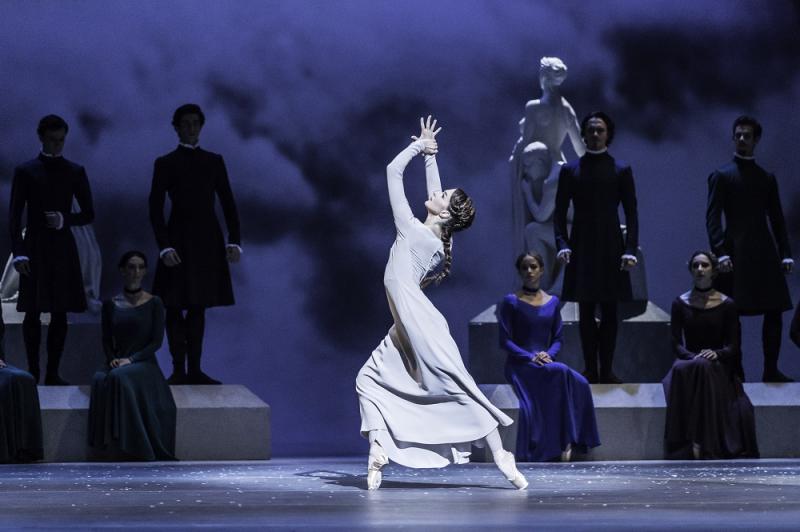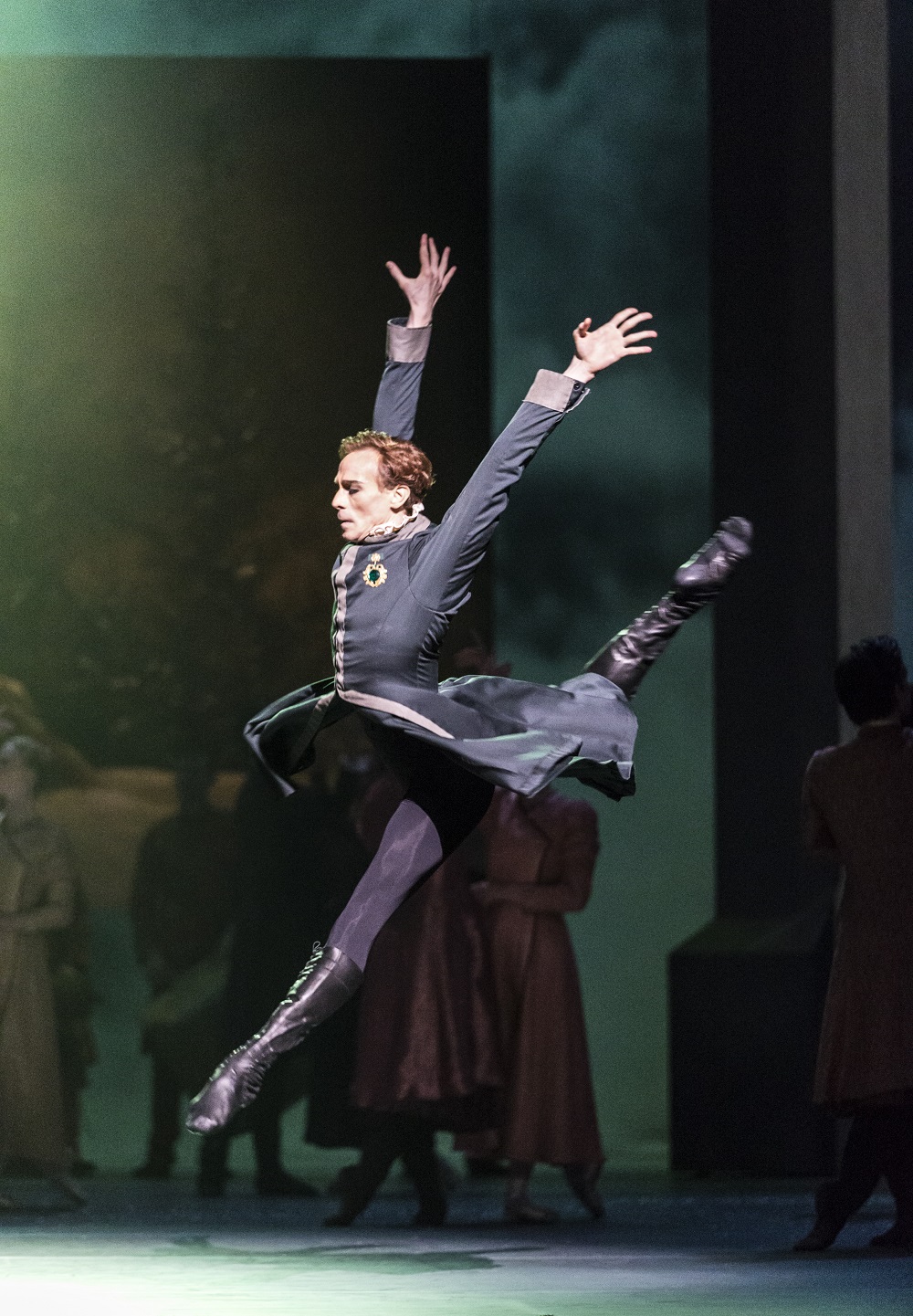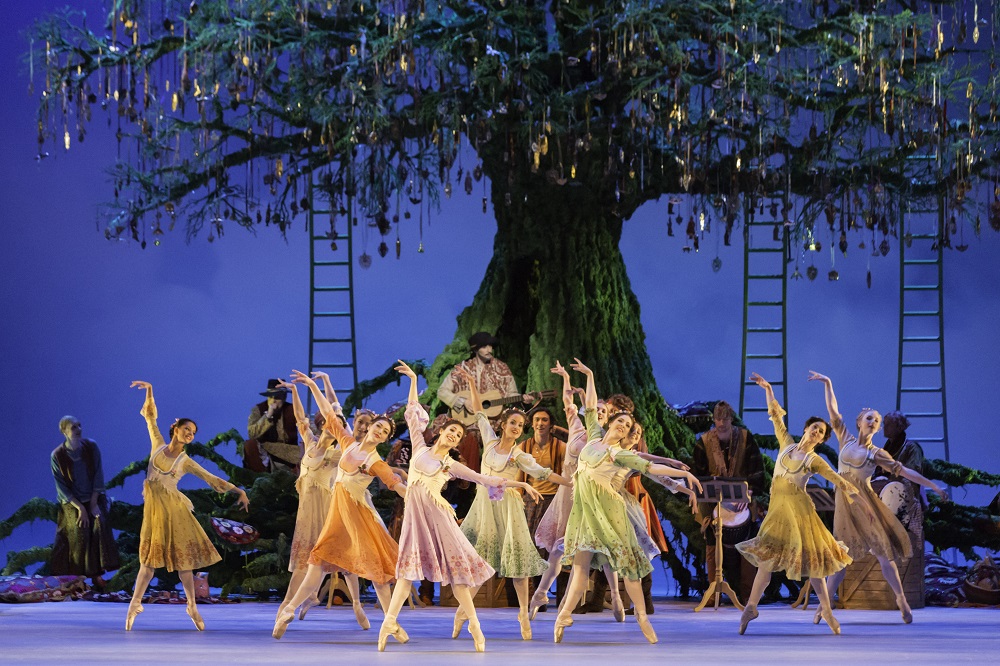The Winter's Tale, Royal Ballet | reviews, news & interviews
The Winter's Tale, Royal Ballet
The Winter's Tale, Royal Ballet
Full Shakespearean breadth, if not depth, in effective revival

It was twelfth night for Christopher Wheeldon's two-year-old, three-act Shakespearean ballet, and this newcomer had one nervous anticipatory question.
Perhaps a play with less magical poetry, like the only-partly-by-Shakespeare Pericles, would have been more friendly to conventional choreography. But in fact this Winter's Tale has a strong balletic structure with its own special flavour: a dark, dramatic first act, the second with its pastoral rebirth coming closest to entertaining divertissement, the last offering the redemption of romance. Two relatively weak finales dominated by clever silk effects and video projections at least have the virtue of symmetry in ship journeys to and from Bohemia.
 Act One belongs to Edward Watson's Leontes (pictured right), with terror in his splayed fingers launching an instant portrayal of mental illness expressed in stylised physicality: more than shades of Mayerling's Crown Prince Rudolf in a character who seems to be on the verge of a Kafka metamorphosis. I well remember Irek Mukhamedov only able to convey the jealousy of Kim Brandstrup's Othello in moments, suggesting that ballet is incapable of fluid psychological development. But the torment of Shakespeare's Leontes is more one-dimensional than that of his Othello, and Watson certainly sustains it.
Act One belongs to Edward Watson's Leontes (pictured right), with terror in his splayed fingers launching an instant portrayal of mental illness expressed in stylised physicality: more than shades of Mayerling's Crown Prince Rudolf in a character who seems to be on the verge of a Kafka metamorphosis. I well remember Irek Mukhamedov only able to convey the jealousy of Kim Brandstrup's Othello in moments, suggesting that ballet is incapable of fluid psychological development. But the torment of Shakespeare's Leontes is more one-dimensional than that of his Othello, and Watson certainly sustains it.
The women also make their mark. Zenaida Yanowsky strikes the right note of authoritative sympathy as nurse Paulina; after the second interval, she dominates both Leontes and the Third Act with the most remarkable gestures of the evening. Lauren Cuthbertson's Hermione only has to mix regal dignity with anguish, but she does it beautifully, the trial scene almost touching depths not reached elsewhere. Sarah Lamb's Perdita in Act Two is her mother's daughter, almost too aristocratic to be taken for a shepherdess; the real fun comes from the Peter Pan of the ballet world Steven McRae as her Florizel, still able in his mid-thirties to project teen spirit. Their various Pas de deux have enough sweet originality to fire up, weaving in and out of ensemble dances (pictured below) which mirror the Balkan influences of the onstage band figuring in all three acts. All five musicians deserve a special credit, absent from the programme.
The sounds of accordion and cimbalom/santoor here are new to the soundworld of Joby Talbot. Otherwise it's familiar from his Alice music, with the same tick-tocking of passing time – or falling snowflakes, perhaps, in this instance – and the darker side of Wonderland kicking off Leontes' pathology. That develops its own identity in the lower brass, superbly counterpointing the women's music in Hermione's chamber, and four chords, half Holst's Uranus, half Messiaen Turangalila stone theme, serve as the only striking leitmotif.
Too often, though, the familiar percussion glitter and tintinnabulations aren't matched by thematic substance. Talbot stands in relation to Prokofiev as Glazunov does to Tchaikovsky, which still isn't bad. There are some bracing changes of metre in the Bohemian act, all of it effective music, but less would sometimes be more, especially so in the final family revelations. Bob Crowley's set, mostly well-lit by Natasha Katz – shame, though, that spotlights are still occasionally in use – is stripped of its columns and Casper David Friedrich canvases to a stark simplicity here which Wheeldon's choreography mirrors in its strangeness. So it's a pity that the score, all of it vividly played by the Royal Opera Orchestra under the admirable David Briskin, should head towards lush overkill. Still, given such high production values, I wouldn't mind seeing a full-length Wheeldon/Talbot Tempest some time in the future.
rating
Share this article
The future of Arts Journalism
You can stop theartsdesk.com closing!
We urgently need financing to survive. Our fundraising drive has thus far raised £33,000 but we need to reach £100,000 or we will be forced to close. Please contribute here: https://gofund.me/c3f6033d
And if you can forward this information to anyone who might assist, we’d be grateful.

Subscribe to theartsdesk.com
Thank you for continuing to read our work on theartsdesk.com. For unlimited access to every article in its entirety, including our archive of more than 15,000 pieces, we're asking for £5 per month or £40 per year. We feel it's a very good deal, and hope you do too.
To take a subscription now simply click here.
And if you're looking for that extra gift for a friend or family member, why not treat them to a theartsdesk.com gift subscription?
more Dance
 Help to give theartsdesk a future!
Support our GoFundMe appeal
Help to give theartsdesk a future!
Support our GoFundMe appeal
 Best of 2024: Dance
It was a year for visiting past glories, but not for new ones
Best of 2024: Dance
It was a year for visiting past glories, but not for new ones
 Nutcracker, English National Ballet, Coliseum review - Tchaikovsky and his sweet tooth rule supreme
New production's music, sweets, and hordes of exuberant children make this a hot ticket
Nutcracker, English National Ballet, Coliseum review - Tchaikovsky and his sweet tooth rule supreme
New production's music, sweets, and hordes of exuberant children make this a hot ticket
 Matthew Bourne's Swan Lake, New Adventures, Sadler's Wells review - 30 years on, as bold and brilliant as ever
A masterly reinvention has become a classic itself
Matthew Bourne's Swan Lake, New Adventures, Sadler's Wells review - 30 years on, as bold and brilliant as ever
A masterly reinvention has become a classic itself
 Ballet Shoes, Olivier Theatre review - reimagined classic with a lively contemporary feel
The basics of Streatfield's original aren't lost in this bold, inventive production
Ballet Shoes, Olivier Theatre review - reimagined classic with a lively contemporary feel
The basics of Streatfield's original aren't lost in this bold, inventive production
 Cinderella, Royal Ballet review - inspiring dancing, but not quite casting the desired spell
A fairytale in need of a dramaturgical transformation
Cinderella, Royal Ballet review - inspiring dancing, but not quite casting the desired spell
A fairytale in need of a dramaturgical transformation
 First Person: singer-songwriter Sam Amidon on working in Dingle with Teaċ Daṁsa on 'Nobodaddy'
Michael Keegan-Dolan’s mind-boggling total work of art arrives at Sadlers Wells this week
First Person: singer-songwriter Sam Amidon on working in Dingle with Teaċ Daṁsa on 'Nobodaddy'
Michael Keegan-Dolan’s mind-boggling total work of art arrives at Sadlers Wells this week
 Akram Khan, GIGENIS, Sadler’s Wells review - now 50, Khan returns to his roots
The dancer-choreographer goes epic in a show that unites South Asian dance styles
Akram Khan, GIGENIS, Sadler’s Wells review - now 50, Khan returns to his roots
The dancer-choreographer goes epic in a show that unites South Asian dance styles
 Maddaddam, Royal Ballet review - superb dancing in a confusing frame
Wayne McGregor's version of Margaret Atwood's dystopia needs a clearer map
Maddaddam, Royal Ballet review - superb dancing in a confusing frame
Wayne McGregor's version of Margaret Atwood's dystopia needs a clearer map
 Pina Bausch’s The Rite of Spring/common ground[s], Sadler’s Wells review - raw and devastating
Returning dancers from 13 African countries deliver celebrated vision with blistering force
Pina Bausch’s The Rite of Spring/common ground[s], Sadler’s Wells review - raw and devastating
Returning dancers from 13 African countries deliver celebrated vision with blistering force
 Legacy, Linbury Theatre review - an exceptional display of black dance prowess
An all-too-fleeting celebration of black and brown ballet talent that demands a reprise
Legacy, Linbury Theatre review - an exceptional display of black dance prowess
An all-too-fleeting celebration of black and brown ballet talent that demands a reprise

Add comment